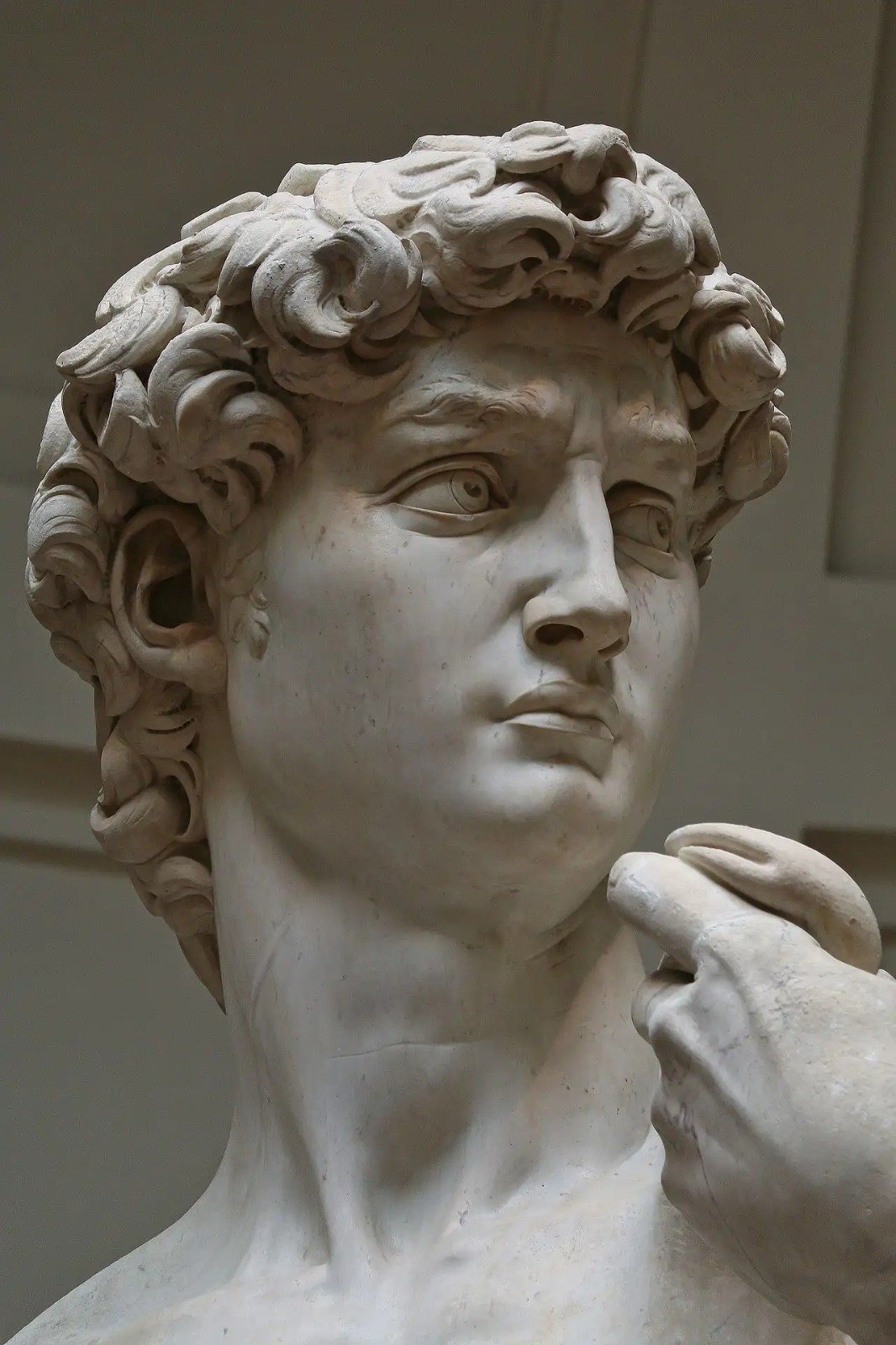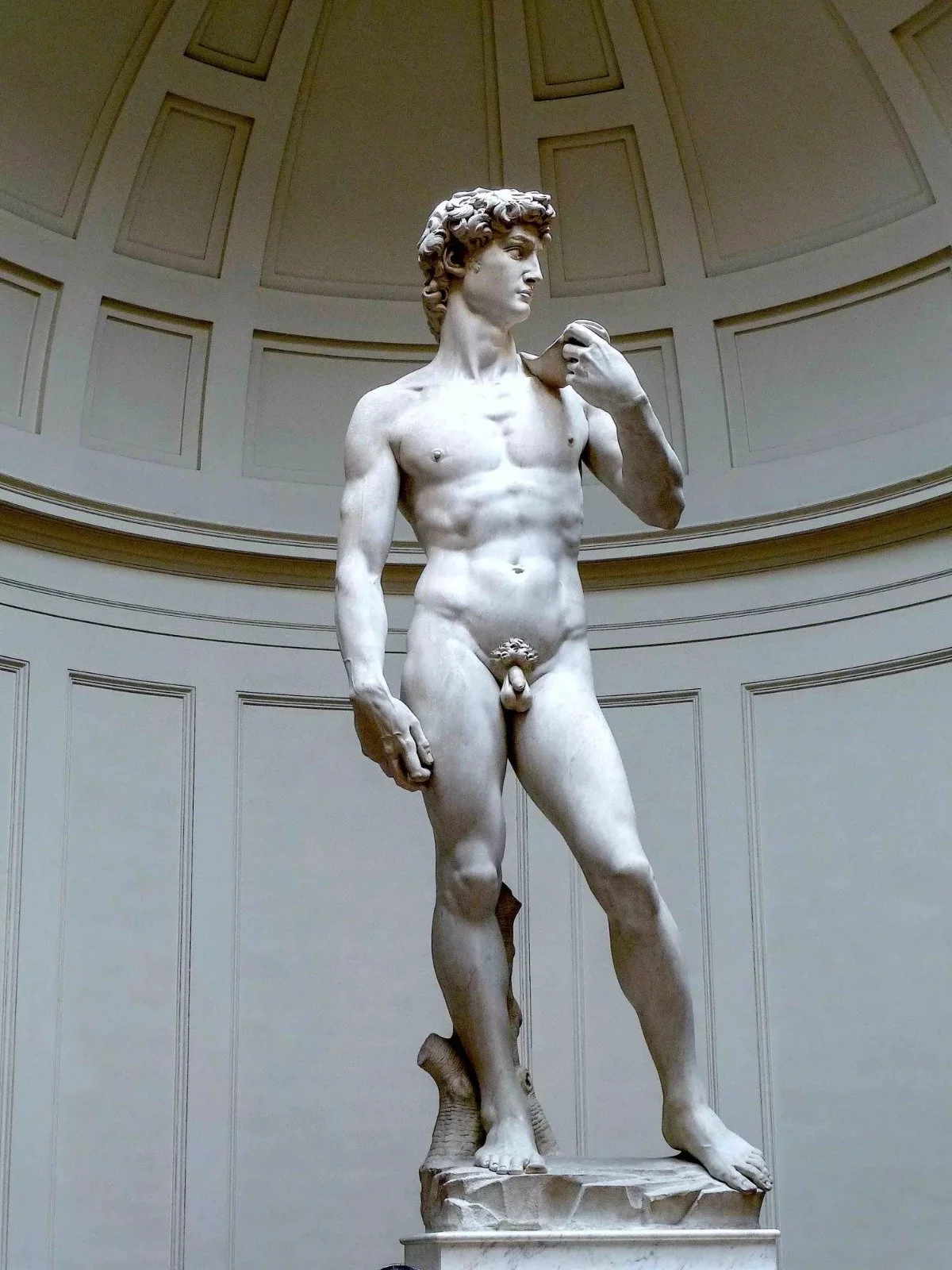MICHELANGELO'S DAVID: AN ICON OF THE RENAISSANCE AND HUMAN VIRTUE
Michelangelo's David is one of the most iconic sculptures of the Renaissance, admired from the very first day it was exhibited. Its artistic grandeur and profound symbolism make it a pinnacle of art history. Unlike previous representations of David, Michelangelo chose to depict the moment before the battle, emphasizing intelligence and concentration over mere physical victory.
The history of this monumental sculpture began forty years before Michelangelo started working on it. In 1463, the authorities of Santa Maria del Fiore Cathedral in Florence commissioned Agostino di Duccio to create a statue of David, but the project remained unfinished. The piece, a massive block of Carrara marble nearly six meters tall, was abandoned in the cathedral’s workshop for decades due to the difficulties of carving it. No sculptor dared to work on it until Michelangelo, a 26-year-old artist, accepted the challenge in 1501.
Michelangelo had a unique conception of sculpture, based on the idea of “liberating” the figure within the stone. He believed that a sculpture was not created but rather revealed, with the artist simply removing the excess marble to expose the preexisting form within the material. In this case, he had to work with a block that had already been partially shaped, posing an additional technical challenge.
The contract was signed in August 1501, and the following month, Michelangelo began working on the piece, concealing his progress with a wooden structure to prevent prying eyes. His dedication was absolute, and he spent twenty-one months sculpting without assistance. Finally, in 1504, the work was completed.
Michelangelo's David stands 5.17 meters tall and weighs approximately 5.5 tons. It is a fully three-dimensional sculpture, designed to be admired from every angle. Its posture follows the classical contrapposto technique, which adds dynamism and balance to the figure.
Unlike previous versions by Donatello and Verrocchio, which depicted David after his victory, Michelangelo captured the moment before the confrontation. The young hero is alert, with a serene yet intense expression. His penetrating gaze, full of determination, conveys the concentration and courage required to face the battle.
David’s physique is that of an athletic man, not a fragile adolescent. Every muscle, tendon, and vein is sculpted with astonishing precision, reflecting Michelangelo’s deep anatomical knowledge, acquired through the dissection of cadavers. The tension is evident in his posture: his right leg bears the weight of his body, while the left remains relaxed, creating a subtle balance between stability and movement.
Michelangelo intentionally employed certain disproportions in the sculpture. The head and right hand are larger in proportion to the rest of the body. This decision was made for two reasons: first, to correct perspective, as the statue was intended to be viewed from below; second, to reinforce the work’s symbolic message. The head represents intelligence and strategy, while the hand emphasizes deliberate action, underscoring the importance of ingenuity over brute force.
Additionally, David holds his sling in a subtle yet significant manner. His left hand rests on his shoulder, gripping the pouch containing stones, while his right hand conceals what appears to be a fustibal, a type of Roman sling. This arrangement reinforces the idea that David triumphs through cunning rather than sheer physical strength.
Michelangelo’s David embodies the ideals of the Renaissance: the celebration of the human body, mastery of anatomy, and the exaltation of intelligence over violence. In this sculpture, the artist not only represents a biblical hero but also the ideal Renaissance man: strong, rational, and in control of his destiny.
The emphasis on the character’s psychology is another innovative aspect. By omitting Goliath’s figure, Michelangelo compels the viewer to focus entirely on David, his mental preparation, and the tension in his body before the attack. This representation moves away from medieval dramatism and approaches a more philosophical conception of human struggle.
Beyond its artistic value, David carried strong political connotations. In 1494, Florence had expelled the Medici family and established the Florentine Republic. The statue was interpreted as a symbol of the new republic, which, like David, had to face its enemies with intelligence and determination.
Initially, the sculpture was intended for the cathedral, but its magnitude and significance led to a reconsideration of its placement. A committee of experts, including Leonardo da Vinci and Botticelli, decided to position it in Piazza della Signoria, in front of the Palazzo Vecchio, the seat of the republican government. This location reinforced its role as an emblem of Florentine resistance against Medici rule.
Transporting the statue was a feat in itself. A team of over thirty men took four days to move the five-and-a-half-ton marble sculpture just 600 meters. Along the way, Medici supporters attempted to damage the statue by throwing stones at it, demonstrating the strong political impact the work already had in the city.
Although the Florentine Republic fell in 1512 and the Medici family regained power, David remained in Piazza della Signoria as a testament to the republican spirit. In 1873, to protect it from the elements, it was moved to the Galleria dell’Accademia, where it remains one of the most visited artworks in the world. A replica was placed in its original location in 1910.
Michelangelo’s David has transcended its time and context, becoming a universal symbol of courage, intelligence, and the beauty of the human body. Its impact on art history is unquestionable, and its message continues to resonate centuries after its creation.
Michelangelo’s David is not only a masterpiece of the Renaissance but also a testament to the power of art to convey universal values. With a perfect combination of technique, symbolism, and political significance, this sculpture continues to amaze generations of viewers, solidifying itself as one of humanity’s greatest artistic achievements.












